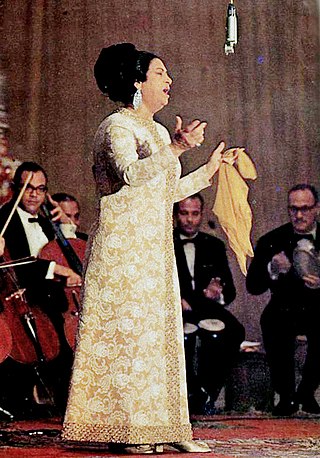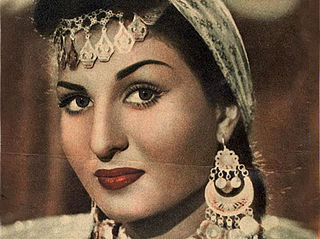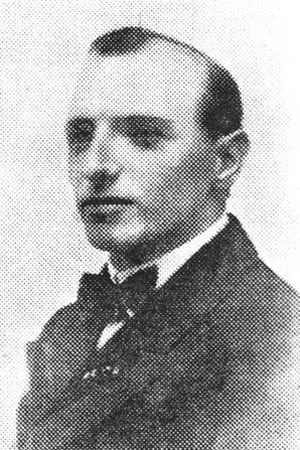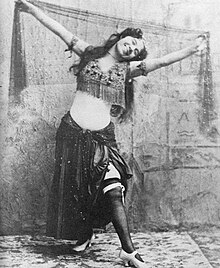
Umm Kulthum was an Egyptian singer, songwriter, and film actress active from the 1920s to the 1970s. She was given the honorific title Kawkab el-Sharq. Immensely popular throughout the Arab World, Kulthum is a national icon in her native Egypt; she has been dubbed "The Voice of Egypt" and "Egypt's Fourth Pyramid". In 2023, Rolling Stone ranked Kulthum at number 61 on its list of the 200 Greatest Singers of All Time.

"Arabian riff", also known as "The Streets of Cairo", "The Poor Little Country Maid", and "the snake charmer song", is a well-known melody, published in different forms in the 19th century. Alternate titles for children's songs using this melody include "The Girls in France" and "The Southern Part of France". The melody is often associated with the hoochie coochie belly dance.

Samia Gamal was an Egyptian belly dancer and film actress. Gamal performed in more than 50 movies during her career. She is regarded as one of the most prominent Egyptian belly dancers in the golden era of Egyptian cinema.

Taheyya Kariokka also Tahiya Carioca, was an Egyptian belly dancer and film actress.

Naima Akef was a famous Egyptian belly dancer during the Egyptian cinema's golden age and starred in many films of the time. Akef was born in Tanta on the Nile Delta. Her parents were acrobats in the Akef Circus, which was one of the best known circuses at the time. She started performing in the circus at the age of four, and quickly became one of the most popular acts with her acrobatic skills. Her family was based in the Bab el Khalq district of Cairo, but they traveled far and wide in order to perform.

Blossom Seeley was an American singer, dancer, and actress.

Fifi Abdou is an Egyptian belly dancer and actress. She has been described as "synonymous with belly dancing in the years she was performing."
Serena Wilson, often known just as "Serena", was a well-known dancer, choreographer, and teacher who helped popularize belly dance in the United States. Serena's work also helped legitimize the dance form and helped it to be perceived as more than burlesque or stripping. Serena danced in clubs in her younger years, opened her own studio, hosted her own television show, founded her own dance troupe, and was the author of several books about belly dance.

The hoochie coochie is a catch-all term to describe several sexually provocative belly dance-like dances from the mid-to late 1800s. Also spelled hootchy-kootchy and a number of other variations, it is often associated with "The Streets of Cairo, or the Poor Little Country Maid" song, also known as "the snake charmer song". "Hoochie Coochie Man" is also a blues standard written by Willie Dixon and first recorded by Muddy Waters in Chicago, January 7, 1954. Numerous cover versions of this classic continue to be recorded. Hoochie Coochie is also mentioned in Alan Jackson's hit country music song "Chattahoochee", and the Jerry Leiber and Mike Stoller songs "Little Egypt (Ying-Yang)" and "Saved".

Nadia Gamal was an Egyptian dancer and actress. She is known of mixing local Egyptian belly dance with Western Waltz, Cowboy, Cha Cha and other.
Coochie, coochee or coochi is an American term often used as a cute or slang word for a vulva. It has also been used as a slang descriptor in relation to a belly dance and related types of movement.
Hossam Ramzy was an Egyptian percussionist and composer. He worked with English artists including Jimmy Page and Robert Plant, Siouxsie Sioux, as well as with Arabic music artists like Rachid Taha and Khaled.

Belly dance is a Middle Eastern dance that originated in Egypt, which features movements of the hips and torso. A Western-coined exonym, it is also referred to as Middle Eastern dance or Arabic dance. It has evolved to take many different forms depending on the country and region, both in costume and dance style; with the styles and costumes of Egypt being the most recognized worldwide due to Egyptian cinema. Belly dancing in its various forms and styles is popular across the globe where it is taught by a multitude of schools of dance.

At Night, They Dance is a Canadian documentary film, released in 2011. Directed by Isabelle Lavigne and Stéphane Thibault, the film profiles a group of belly dancers in Cairo, Egypt.

Little Egypt is a 1951 American Technicolor comedy drama film directed by Frederick de Cordova starring Mark Stevens and Rhonda Fleming. It is a highly fictionalised biography of the dancer Little Egypt in the 1890s.

Badia Masabni (Arabic: بديعة مصابني, born Wadiha Masabni was a belly dancer, singer, actress, night club owner and businesswoman considered as the developer of modern belly dancing, by bringing the Western and Hollywood-esque vibe into it, after living for several years in the Americas since the age of seven.

The important place of women in dance can be traced back to the origins of civilization. Cave paintings, Egyptian frescos, Indian statuettes, ancient Greek and Roman art and records of court traditions in China and Japan all testify to the important role women played in ritual and religious dancing from the start. In the Middle Ages, what has become known as ballet had its beginnings in Italian court festivals when women frequently played the parts of men. It was however in late 17th-century France that the Paris Opera produced the first celebrated ballerinas. While women began to dominate the ballet scene in the 18th century, it was with the advent of Romantic ballet in the 19th century that they became the undisputed centre of attraction with stars playing the leading roles in the works of Marius Petipa, appearing in theatres across Europe from Milan's La Scala to the Mariinsky Theatre in Saint Petersburg. More recently, women have played a leading role in developing various forms of modern dance including flamenco and expressionist dance.

James Henry White was a Canadian film pioneer, who worked as a director, producer, and cinematographer. He also appeared as an actor in several films. He was employed by the Edison Manufacturing Company as Production Head from 1896 to 1902, and directed over 500 short films, both fictional and documentary. With no functional story or script, just scenes or vignets, White proved prolific and tried to be lyrical in some of his short films i.e. Return of a Lifeboat (1897) and A Storm at Sea (1900) the latter of which was shot on a passenger ship with the camera catching some of the glimmer from the sun.

Arab folk dances, also referred to as Oriental dance, Middle-Eastern dance and Eastern dance, are the traditional folk dances of the Arabs in Arab world. Arab dance has many different styles, including the three main types of folklore, classical, and contemporary. It is enjoyed and implemented throughout the Arab region, from North Africa to the Middle East.

Layla Taj,, is an American belly dancer in the classical Egyptian raqs al-sharqi style. The focus of her repertoire is to communicate facets of Egyptian culture.

















